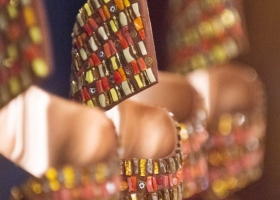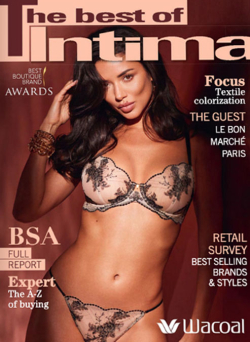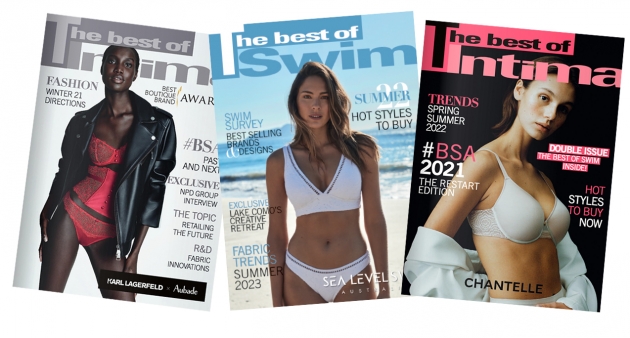
The Best ofIntima & Swim Edit
INTIMA'S ANNIVERSARY Back to 1957
11 January 2017
That very year, a young Italian entrepreneur and distributor of several well-known lingerie brands, including Triumph, had the idea of creating promotional materials with photos of lingerie on live models.
However, in Italy at this time, it was difficult to find, attractive young women willing to pose in states of undress… especially as the photos were to be published in Italy's first lingerie magazine! That is the story how Vito Pisani bacame a publisher. Sixty years later, the Milan-based agency has become Intima Media Group, a leading B2B communications company, with a global presence that includes six titles and numerous yearly events. Ghislaine Rayer and Patrice Gaulupeau, experts and collectors of lingerie, take us on a journey back to 1957 in culture and fashion.
The big picture
NEW WORLD ORDER
In 1957, the post World War II era was in full swing, with Dwight D. Eisenhower enjoying his second term as President of the United States, with VP Richard Nixon at his side. In June of that year, a coup attempt was carried out against Stalin’s successor, Soviet leader Nikita Khruschev, by oldschool, hardliners who opposed his liberalization policies. In China, Mao Tse-Tung was carrying out his first Five-Year Plan, which sought to transform the country into a world power through rapid industrialization. The world was recovering from the Suez Canal Crisis – the most dangerous postwar incident to that date – but peace was restored by spring 1957, when the waterway reopened. The Cold War between the USSR and the West was in full gear, characterized by a frightening build-up of nuclear weapons. Tensions moved into space, when, in 1957, the Soviets launched Sputnik, the first artificial satellite to orbit the Earth; the Space Race had begun, which created a two-nation balance of power between Russia and the US, the world leaders in scientific and technological advancement during this period.

THE POST-WAR BOOM
By 1957, the scarcity of the war years was now comfortably in the past, and the world was enjoying a full-blown economic boom. Mass production and infrastructure spending led to a dizzying increase in international trade. It was not only the economy that exploded; buoyed by the prospect of future prosperity, the birthrate soared, creating the Baby Boom, which lasted from 1945 to the mid-1960s. In Europe, the Treaty of Rome was signed on March 25, 1957 between France, Italy, West Germany, Belgium, Netherlands, and Luxembourg, creating the European Economic Community (EEC), the forerunner of the EU. This agreement paved the way for the free movement of people, goods and capital between member states. The European Atomic Energy Community (Euratom) was also established in 1957 for the peaceful development of nuclear research.

EUROPEAN TAKE TO THE ROAD
Even if the average American had been driving around since the Model T Ford debuted in 1908, the automobile didn’t become part of everyday European life until the 1950s, when urbanization required a new means of transport; cars also became a symbol of economic prosperity during this period. In East Germany, the first Trabant – dubbed the “people’s car” – rolled off the assembly line in 1957, and was the only car available in the DDR for many years to come; it finally ceased production in the 1990s. In July 1957, Turin-based auto manufacturer, Fiat, launched the first 500, Italy’s answer to the VW Bug. It revolutionized the idea of utilitarian cars and became an international icon of industrial design.
Life in the 1950s

THE RISE OF THE TEENY-BOPPER
In the peaceful-and-prosperous 1950s, for the first time in the 20th century, the majority of young people faced a future free from war and unshakeable poverty. While earlier generations moved from childhood straight into adult life and responsibilities, a new demographic sprang up – the teenager. Adolescents had the freedom to explore the world in shiny automobiles, listening to the latest music on phonographs behind locked bedroom doors, far from the family. A distinct teen culture emerged with its own music, celebrity idols and fashion. Young people embraced fads such as the Hula Hoop and the Frisbee, which was introduced in 1957. While many squeaky-clean teens hung out at sock hops and soda fountains, the 1950s also witnessed the emergence of a youth counter-culture that questioned authority and the hypocrisy of their elders, as evidenced by hit films like Rebel Without a Cause.
THE BEAT GENERATION!
While things seemed peaceful and idyllic in the 1950s, a radical counter-culture movement was taking hold in the arts. Abstract expressionism broke down the limitations of figurative art to a state of pure thought and emotion. In 1957, the Leo Castelli Gallery opened, which became the epicenter of the New York art world, showcasing the revolutionary works of Jasper Johns and Robert Rauschenberg, among others. In literature, Allen Ginsberg’s collection Howl and Other Poems had been banned for crude language and obscenity for its depiction of drug use and homosexuality; a landmark first-amendment trial in 1957 deemed the work of “redeeming social importance.” Jack Kerouac published On the Road, written in spontaneous prose, which took its cues from improvisational jazz. The book became the bible of the Beat Generation, whose members were christened “beatniks,” after the Russian satellite Sputnik, launched the same year. Other notable books of 1957 include: Ayn Rand’s Atlas Shrugged, Boris Pasternak’s Doctor Zhivago – which had been banned in the USSR – and Dr. Seuss’ Cat in the Hat.

REBELLIOUS ROCK ’N’ ROLL ANS LUSH ORCHESTRATIONS
In 1957, Elvis Presley’s Jailhouse Rock and All Shook Up topped the charts, while jukeboxes blasted Great Balls of Fire by Jerry Lee Lewis, Wake Up, Little Susie from the Everly Brothers, and Paul Anka’s Diana. Bobby Helms recorded, Jingle Bell Rock, one of the most cloying Christmas songs of all time. Meanwhile, jazz, swing and big band melded into a new, sophisticated sound epitomized by Ella Fitzgerald’s Great American Songbook recordings for Verve Records. A more mature Frank Sinatra emerged, who was at the peak of his Capitol years, releasing recordings such as Autumn Leaves and The Lady is a Tramp. Jazz was moving to a whole new level, incorporating techniques from classical music; the 1957 release of Miles Davis’ seminal album, Birth of the Cool, gave the name to this new movement, Cool Jazz.
FROM CINEMASCOPE TO THE SMALL SCREEN
In 1957, going to the cinema was an event, complete with a beautiful theater, ushers, a red velvet curtain, and a full program of news, shorts, serials and the main feature. The smash hit of 1957 was the David Lean epic, the Bridge on the River Kwai, starring Alec Guinness and William Holden. Films of this period were lavish, colorful and frothy, often filmed in glorious Cinemascope. Soapy, star-studded tearjerkers like Peyton Place starring Lana Turner and An Affair to Remember, with Cary Grant and Deborah Kerr, attracted women, as did girl-inthe-city romantic comedies such as the Tracy/Hepburn vehicle, Desk Set. Musicals remained staple movie fare, including Fred Astaire’s Silk Stockings and Funny Face. No discussion of 50’s cinema would be complete without a mention of western’s and science fiction; 1957 saw the release of the classics Gunfight at the OK Corral, 3:10 to Yuma, Old Yeller and the Incredible Shrinking Man. Cracks were starting to show in the Hollywood studio system, and independently produced films with dark, cynical, psychological themes shot in a realistic manner were offering a glimpse of the future; examples include 12 Angry Men and Sweet Smell of Success. TV brought moving pictures into the living room, and 1957 saw the debut of Perry Mason and Zorro.
THE DAWN OF THE SEXUAL REVOLUTION
While the 1950s were incredibly repressive times, the seeds of the 60s were being sown. Playboy magazine debuted in 1953, which made high-class, soft-core pornographic images acceptable for mainstream American gentleman. This was also the golden era of the Pin-Up Girl. While lingerie ads were highly posed and sanitized, Pin-Ups featured real women, fleshy and full of life, often posing in bondage-inspired photoshoots. The greatest glamour girl of all time was Bettie Page. She has become an icon of independent women and lingeristas world-wide, with few women having had such a profound influence on popular culture. Bettie designed and handmade most of the lingerie used in her photoshoots; these styles were mined for ideas by a huge number of modern-day lingerie and swimwear brands and a remarkable number of present-day styles were actually Bettie’s invention. The year 1957 marked the peak of Bettie’s popularity, as well as its end; in 1958, she became a bornagain Christian and retired from modeling.
THE HAPPY HOMEMAKER
During the war years, women lived very independent lives. They went to work and earned their own living. When the men returned from the front, however, women were expected to remove themselves from the workplace. The 1950s saw the return of strict gender roles: women were to take care of the home and children, while men were to provide for their families. While female universities offered top-rate educations, there were few opportunities outside the home upon graduation. Women, therefore, often opted to attend finishing schools, which taught them how to act like proper young ladies in terms of dress and deportment, to ensure future husbands that their prospective bride would know how to entertain and make a good impression on colleagues and friends. Also during this period, a new array of domestic appliances greatly reduced the amount of housework that needed to be done, liberating women from a number of repetitive chores. With less domestic work to do, their men at work and children at school, women began to feel more-and-more stifled. Firstwave feminist Betty Friedan later described the housewife life of the period as “burying women alive.” In order to cope, women increasingly turned to “peace pills” or “mother’s little helpers.” The extremely strong tranquilizer Miltown accounted for one-third of all prescriptions in the year 1957.
FAST FACTS FOR 1957
The Hamilton Watch Company launched the first electric wristwatch. Althea Gibson was the first person of color to win the Wimbledon tennis tournament.
Leonard Bernstein’s West Side Story debuted on Broadway, the first musical to tackle controversial social issues. Gentleman’s Quarterly (GQ) magazine released its first issue.
While the saying “In God We Trust” appeared on coins as far back as 1864, it made it’s debut on US paper money in 1957. l Martin Luther King founded the African-American civil rights organization, the Southern Christian Leadership Conference (SCLC), and became its first president. He also appeared on the cover of Time magazine for the first time. William Hanna & Joseph Barbera set up Hanna-Barbera Productions, and went on to create some of the best-loved, most trippy characters in cartoon animation:
Tom & Jerry, Yogi Bear, the Flintstones, Scooby Doo, the Banana Splits, the Jetsons, Johnny Quest and Josie and the Pussycats, to name just a few.
NOTABLE ACHIEVEMENTS: 1957
The Nobel Prize
Peace Prize: Lester Pearson, Canadian politician, for his role in the resolution of the Suez Canal Crisis
Literature: Albert Camus, French author, philosopher, essayist, dramatist, and activist
Medicine: Daniel Bovet for research relating to the vascular system
Physics: Chen Ning Yang and Tsung-Dao Lee, the first Chinese nationals to win a Nobel Prize, for their work on parity laws
Chemistry: Lord Alexander Robertus Todd, for his work on nucleotides and nucleotide co-enzymes
The Academy Awards, March 25, 1957
Best Picture: Around the World in 80 Days, starring David Niven and Shirley MacLaine
Best Actor: Yul Brynner, The King and I
Best Actress: Ingrid Bergman, Anastasia
Best Director: George Stevens, Giant. The last of only three films starring James Dean, who died in a car accident after filming.
Best Foreign Film: La Strada (Italy), directed by Federico Fellini and starring Anthony Quinn
Tony Awards: Best Musical: My Fair Lady, with Julie Andrews Pulitzer Prize for Autobiography: Profiles in Courage, by the young Senator John Fitzgerald Kennedy Miss USA 1957: Miss Maryland, Mary Leona Gage, was stripped of her title after it emerged she was an 18-year-old, twice married, mother of two. The crown passed to Miss Utah, Charlotte Sheffield, but, due to bureaucratic delays, she was unable to compete in the Miss Universe pageant, the only time Miss USA did not appear in the contest.
Fashions of the 1950s

IN FRANCE: HAUTE-COUTURE REIGNS SUPREME
The 50s were the golden age of Parisian haute couture, as well as the birth of the prêt-à-porter industry. Chrisitan Dior, who created the New Look style that predominated 50s fashion, suddenly died in 1957 at the age of 52. His successor was a talented 21-year-old named Yves Saint Laurent. He created radically new silhouettes in the late 50s with his loose-waisted, proto A-line Trapeze dress and high-waisted, fluid Empire model. Hubert de Givenchy released his famous sack dress in 1957, which was waistless and shapeless. Couture became more accessible and less elitist; other standout designers of the decade include Balmain, Patou, Jacques Heim, Jacques Fath, Cardin and Balenciaga. There were also a surprisingly large number of female designers with their own fashion houses such as Nina Ricci, Maggy Rouff, Madame Grès, Lanvin and the most famous of all, Coco Chanel, whose famous, and perennially stylish, Chanel suit was released in the mid-1950s.
FASHION ICONS OF THE SILVER SCREEN
Marilyn Monroe With her perfect hourglass figure and doe-eyed visage, Marilyn Monroe was the sex symbol of the decade, if not all time. During the 1950s, she graced the cover of the very first issue of Playboy and shall be forever remembered for her iconic pose – in a billowing white dress above a subway grate – in the film, The Seven Year Itch.
Grace Kelly’s icy-cold, patrician good looks and aristocratic style skyrocketed her to fame after her debut as a leading lady in High Noon, alongside Gary Cooper. This Yankee blueblood also became the first American Princess when she married Prince Rainier of Monaco in the wedding of the century. Audrey Hepburn formed her 40-year collaboration and friendship with designer Hubert de Givenchy when he dressed her for her breakout role in Sabrina. He continued to dress her in the 1950s and beyond, eventually creating the famous little black dress for Breakfast at Tiffany’s. Audrey Hepburn’s hallmark style was thoroughly modern, defined by stripped-down minimalism, without ever sacrificing femininity.
Elizabeth Taylor The 1950s saw La Liz transition from child star to wide-eyed ingénue to full-blown diva, whose sultry sensuality was always tinged with a non-threatening vulnerability. She also forever became an icon to the lingerie community with her role as Maggie the Cat in the film adaptation of Tennessee Williams’ Cat on a Hit Tin Roof, in which she spent a huge chunk of screen time in nothing but a slinky negligee.
Sophia Loren For the first time since the 1920s, Hollywood started embracing foreign actresses with exotic good looks, and none shone more brightly than the voluptuous Sophia Loren. With her Mediterranean curves and seductive accent, she brought a carnal, distinctly Italian, sexuality to her screen roles opposite Cary Grant, Anthony Quinn and William Holden.
Brigitte Bardot was France’s answer to the blonde bombshell –strikingly beautiful with an aura of aloof mystery. The term “sex kitten” was invented just for her. Her breakout role in Roger Vadim’s And God Created Woman catapulted her to international stardom. She popularized many fashionable styles, including the Bardot neckline – a wide, open neck that exposes the shoulders –as well as the bikini, capri pants, wide-belted dresses, gingham, ballerina flats, and an early incarnation of the beehive hairdo.

FASHION TRENDS OF THE 1950s
Women of the 1950s were concerned with one thing – looking ultra-feminine. The decade was defined by Christian Dior’s New Look, which made its debut in 1947. After the austerity and rationing of the war years, fabric was back. The New Look was defined by a full, mid-calf length skirt and tiny, wasp waist, which emphasized the bust. Throughout the decade, many silhouettes, including the famous “hourglass,” came in and out of fashion, with one constant, a tiny waist. In 1957, full skirts in colorful patterns were popular, as were strapless dresses and figure-hugging, belowthe-knee pencil skirts, made popular by Marilyn Monroe and Grace Kelly. By the end of the decade, a more relaxed style was taking hold, with capri pants and looser fitting dresses.
Other major trends of the decade include:
Democratic Denim A long-time mainstay of cowboys and workers, blue jeans crossed over into mainstream fashion in the 1950s, embraced by men and women of all ages, from little children to adults. Celebrities like Marilyn Monroe and Lucile Ball wore them without ever sacrificing their femininity, and the style became a veritable uniform for teenage greasers. Throughout the world, much like Coca-Cola or rock ‘n’ roll, jeans became synonymous with American culture – relaxed, casual, egalitarian, rebellious and fun.
Saddle Shoes and Kitten Heels If asked to name the one fashion item that defines the 1950s, black-and-white saddle shoes, often worn with bobby socks, immediately spring to mind. This unisex style was a hit among teens, with Elvis famously wearing them in the 1957 film, Jailhouse Rock. Another popular style was the kitten heel. After the dizzying heels of the 1940s, the dainty, pointy-toed kitten heel was the perfect accompaniment for the prim-andproper styles of the 50s.
Statement Bags The 1950s introduced two of the most legendary handbags in fashion history. In February 1955, Coco Chanel launched the 2.55 Bag – named after its release date – the iconic quilted bag with gold-chain straps, which has become synonymous with brand ever since. Meanwhile, in 1956, Hermès launched its oversized Kelly Bag, named after Grace Kelly, who used it to discretely hide her pregnancy during public appearances.
Got to Have Gloves Gloves were de rigeur in 1950s fashion. Long gloves that came to the elbow, in silk or satin, were sophisticated accompaniments to elegant eveningwear, while short gloves cut at the wrist were worn in the day, during summer and winter.
Lingerie in the 1950s
LINGERIE’S GOLDEN AGE
In France, just as for haute couture, the 1950s ushered in an era of change and evolution for lingerie. The industry’s leading brands were practically all replaced within twelve short years, from 1946 to 1958. Legendary brands like Libron, Silhouette, Star and Prestige all disappeared; the exceptions were historic labels that adapted to dramatic shifts in manufacturing and distribution, such as Cadolle, as well as Barbara, Lejaby and Scandale, who had their roots in the 1930s. New brands filled the gap: Lou, Boléro, and Empreinte in 1946; Rosy in 1947; Simone Pérèle in 1948; Chantelle in 1949; Lise Charmel in 1950 and Aubade in 1958. The situation was similar in Germany. Brands that survived the tumult of the war included heritage labels like Felina, Triumph, and Anita, which all date back to the mid-1880s. Triumph launched its famous Amourette model in 1954, which is still in production today, and Anita moved its headquarters to West Germany after the division of the country. In Italy, Imec was a well-known brand, and in 1954, the legendary La Perla was founded, which to many is the ne plus ultra in luxury lingerie, even today. Other brands that were popular on the world market include PrimaDonna (1865) Zimmerli (1871), Calida (1941) and Hanro (1884) from Switzerland, as well as the Italian Ragno (1879), Lisanza (1920) and Oscalito (1936), or the Austrian Wolford (1950). In the USA, Warner’s, which dates back to 1874, was sold alongside Maidenform and Platex, famous for its latex girdles. Finally, global megabrand Wacoal was founded in 1946 in Japan.
LINGERIE IN 1957
The French lingerie union, the Chambre Syndicale de la Haute Corseterie, set the following rules which had to be followed by its members in 1957: “The chest should be extended, the breasts round, the hips curved. Specialized bras and girdles are necessary to create a smooth and elegant shape, essential for the season’s new dresses.”
In 1957, two different silhouettes were in fashion: tight-fitted dresses, and dresses with a small waist and full skirt. French magazines at the time gave readers the following lingerie advice:
For a fitted dress, a one-piece corselet or a high-waisted girdle accompanied by a longline bra or bustier - For dresses with a full skirt and wasp waist, a basque to shape the chest and upper hips, or a corselet with attached garters.
Petticoat Junction
In order to give shape to full skirts, it was necessary to wear a petticoat. Made from rayon, cotton, or taffeta, a petticoat could be single or double-layered, and trimmed with ruffles or rigid lace. While they were often white, they were also available in bright colors and floral prints. In France, luxurious models were sold by brands like Hélios, Gui, Chesterfield and, especially, Neyret, whose production was almost at the level of haute couture. American girls often ordered petticoats from Sears and J. C. Penney catalogues. This style remained popular through the early 60s, and its most extreme form was a stiff, hooped crinoline.
Stockings Go Seamless
In the 1940s, creative women, dealing with war rationing, used to draw lines on the back of their legs to give the illusion of wearing stockings. In the mid-1950s, thanks to the circular loom, seamless hosiery was invented. Stockings had to be worn with the ever-sexy garter belt, until the invention of pantyhose in 1959, which covered the wearer from the waist to the toe – and whose appearance paved the way for the miniskirt.
Perky and Pointy
In the 1950s, a small waist with a pointy, ample bust that sat high on the chest was the ideal figure, both in Hollywood and at home. Bullet bras and longline bras helped create this coveted cleavage. In the USA, novelty items emerged to help women achieve the generous proportions that were stylish at the time. Lingerie brand, La Resista, marketed a model named the Très Secrète, a push-up bra that could be inflated to different sizes with a straw. While the Americans used French-sounding names to add allure, the opposite was sometimes true across the pond. When the French label, Scandale, later introduced its own inflatable bra, they named it the Very Secret. In 1956, the French brand, Lejaby, launched the plunge bra, which was popular through the mid-1960s.
Smoothing and Shaping
The popular tight-fitting dresses of the 1950s required lingerie that smoothed out the figure. One-piece corselets offered maximum shaping, but were also a bit restraining. For those preferring separates, a high-waisted girdle, made from elastic and nylon, created a smooth line for the belly and back, while narrowing the waist. Bottom edges were elasticized to ease walking. Legged panty girdles were also worn under tight-fitting capri pants to provide a perfectly rounded shape. A slip was worn over bras and shaping garments to ensure there were no visible lines.
Naughty Nighties
In the closing days of 1956, a scandalous movie hit the cinemas, which also unleashed a new form of lingerie into the public consciousness that became all the rage in 1957. Time magazine dubbed the film, “Just possibly the dirtiest American-made motion picture that has ever been legally exhibited.” Based on the Tennessee William play, Elia Kazan’s work starred Carroll Baker as a sexually curious 19-year-old Lolita who spends her days lounging in a crib-like bed, sucking her thumb, clad only in a short, flared, Aline negligee. This style ended up taking its name from the film: Baby Doll. The look was actually invented during the 1940s, when war-time fabric rationing forced legendary American lingerie designer, Sylvia Pedlar, to get creative by making the traditional nightgown as short as possible. While the style was available for years, it remained under the radar until it exploded in 1957. It has remained a popular staple in intimate apparel until this day.
REVOLUTIONARY FABRICS
Most lingerie sold in the USA in the 1950s was made from cotton knit, rayon, nylon, or satin, while girdles were made from nylon or Lastex. Lastex, invented in 1930, was called the Miracle Yarn. It combines a rubber latex fiber with another yarn, such as cotton, silk or viscose, creating a stretchy fabric. Lastex was far from the hightension fabrics of the future, but it was still an extreme step forward at the time. It was used extensively in lingerie and swimwear. Nylon was invented in 1939 by DuPont, and was originally used for hosiery. In 1940, however, the company turned its full attention to manufacturing nylon parachutes for use in the war, and halted the production of stockings. At the end of the war, nylon was used in all aspects of daily life, but especially for lingerie. Easy to wash, quick-drying and wrinkle-proof, this fiber radically changed the lives of women. The final mention goes to polyester. The world’s first polyester factory was built in 1950 in Delaware by DuPont and rapidly gained popularity for use in a wide variety of clothing, including lingerie. It was cheap, easy to wash and did not wrinkle. It created a rougher fabric than nylon or rayon, so was often used for less expensive lines, making stylish undergarments affordable for all women.
LINGERIE DREAMS
Founded in 1922, Maidenform is one of America’s most important lingerie manufacturers of all time. In the 1950s, they released their legendary advertising campaign, “I Dreamed I…in My Maidenform Bra,” which ran for over 20 years. Each advertisement would feature a new adventure that a woman dreamed she did in her lingerie; in 1957, these include: having tea for two; posing for a fashion ad; crashing the headlines; getting lost in the London fog; and racing the wind. In France, a few companies, such as Scandale, would show seductive women in come-hither poses, but the majority of advertising showcased wifely problems relating to pleasing her man, such as the LOU ad which said, “My husband is right, my old bra did make me look heavier.”
Throughout the decade, lingerie advertising increasingly shifted from illustrations to favor the use of live models; in both, women were featured in stiff, artificial poses. It wasn’t until the 1960s that societal changes unleashed a new female archetype for use in lingerie advertising – one that was active and liberated, feminist and feminine.
To be continued this summer with a swimwear special!
Copyright 2025. All right reserved - Terms








